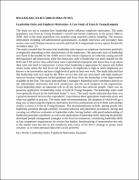| dc.description.abstract | RWAJEKARE JULIUS (2006-03-MBA-PT-067)
Leadership Styles and Employee Motivation: A Case Study of Ernst & Young Kampala
The study set out to examine how leadership styles influence employee motivation. The study population was Ernst & Young Kampala‟s current and former employees in the period 2004 to 2008. Half of the study population was sampled using stratified random sampling. The research instruments including self-administered questionnaires, in-depth interviews and secondary data review were used. Human resources records and Ernst & Young people survey reports formed the secondary data. 115
The study revealed that the autocratic leadership style impacts on employee motivation positively or negatively depending on the characteristics of the employees. The autocratic style of leadership was found to be suitable for the AABS service line whose employees are relatively young and still need guidance and instructions while the democratic style of leadership was more suitable for the BAS and TAS service lines which have more experienced employees who know how to go about their tasks and need no instructions. Laissez-faire leadership is appropriate for mature and skilled senior teams where the skill level and competence of employees is high or when employees are known to be trustworthy and have a high level of pride in their own work. The study indicated that this leadership style was used by the ITRA service line and was associated with high employee turnover because employees lacked guidance and focus from the leadership of the opportunities available in the firm. The study indicated that a manager's leadership style contributes directly to the subordinates' motivation and work satisfaction, and the work progress in the organization. Good leadership plays an important role in all the factors that motivate people. There was no proactive application of leadership styles at Ernst & Young Kampala. The leadership styles used were generally driven by the individual leader‟s views. The study results indicated that there was a general mismatch between the respondents‟ expectations about appropriate leadership styles and what was applied in practice. The study made recommendations, the adoption of which will go a long way in improving the employee motivation levels for professional services firms with settings similar to those of Ernst & Young Kampala. The recommendations include, putting people into leadership positions through carefully executed selection and placement procedures, having and carrying out effective evaluation of leadership styles, having leaders with good understanding of leadership principles and theory as well as the application of leadership skills, tailoring the globally developed people management strategies to the local circumstances, considering leadership skills as key competence requirements for service line leaders, benchmarking of remuneration not only to the market rates but also to job complexity and review of the firm‟s strategy to ensure more certainty as to when personal objectives can be achieved.
Key Words: Leadership Styles, Employee Motivation, Kampala | en_US |


